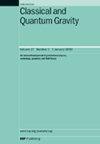(螺母)壳中的c -公制
IF 3.6
3区 物理与天体物理
Q2 ASTRONOMY & ASTROPHYSICS
引用次数: 0
摘要
我们在维度上对c度规进行了全面的研究,将其置于应力能的壳中,并将其与外部真空反德西特度规相匹配。c度规不是圆对称的,因此构造的外壳也不是圆对称的,而是呈尖角或泪滴形状。我们将壳的应力能解释为一种完美的流体,计算能量密度和压力。对于加速粒子(I类),我们发现应力能集中在离加速方向最远的壳体部分,并且总是尊重强能和弱能条件。对于加速黑洞(I类、II类和III类),根据外部度规的参数,壳应力能可能尊重或违反能量条件——在这两种情况之间存在一个外部参数的临界值,壳应力能消失,从而导致爱因斯坦场方程的新解,它分为三类:一个被一端有点粒子的有限长弦拉着的加速黑洞,一个被一端有点粒子的有限长支柱推着的加速黑洞,以及一个被一端有点粒子的有限长支柱从一边推着的加速黑洞,和另一端有点粒子的有限长弦从另一边拉着的加速黑洞。本文章由计算机程序翻译,如有差异,请以英文原文为准。
C-metric in a (nut)shell
We present a comprehensive study of the C-metric in dimensions, placing it within a shell of stress energy and matching it to an exterior vacuum anti-de Sitter metric. The C-metric is not circularly symmetric and hence neither are the constructed shells, which instead take on a cuspoidal or teardrop shape. We interpret the stress energy of the shells as a perfect fluid, calculating the energy density and pressure. For accelerating particles (Class I), we find the stress energy is concentrated on the part of shell farthest from the direction of acceleration and always respects the strong and weak energy conditions. For accelerating black holes (Class I , II, and III), the shell stress energy may either respect or violate the energy conditions depending on the parameter of the exterior metric—between the two regimes lies a critical value of the external parameter for which the shell stress energy vanishes, leading to new solutions of Einstein’s field equations, which fall into three categories: an accelerated black hole pulled by a finite-length string with a point particle at the other end, an accelerated black hole pushed by a finite-length strut with a point particle at the other end, and an accelerated black hole pushed from one side by a finite-length strut and pulled from the other by a finite-length string, each with a point particle at the other end.
求助全文
通过发布文献求助,成功后即可免费获取论文全文。
去求助
来源期刊

Classical and Quantum Gravity
物理-天文与天体物理
CiteScore
7.00
自引率
8.60%
发文量
301
审稿时长
2-4 weeks
期刊介绍:
Classical and Quantum Gravity is an established journal for physicists, mathematicians and cosmologists in the fields of gravitation and the theory of spacetime. The journal is now the acknowledged world leader in classical relativity and all areas of quantum gravity.
 求助内容:
求助内容: 应助结果提醒方式:
应助结果提醒方式:


